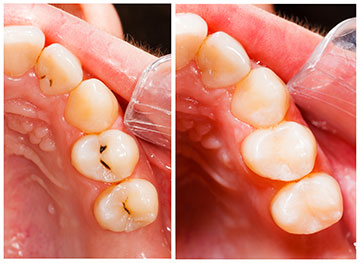Advancements in modern dentistry have given us new options for dental restorations.
Tooth-colored dental fillings, a substitute for silver fillings, offer a natural-looking alternative to amalgam. And unlike silver dental fillings, white fillings can actually be structured to resemble real teeth!
At Kingfisher Dental Designs, we offer tooth-colored fillings as a dental restoration. White fillings are now made with materials that offer the durability we’ve come to expect from amalgam fillings.

The New Standard

There Are Several Types of Tooth-Colored Fillings Available:
Composite Fillings — Also known as composite resin fillings, these are the most common of the tooth-colored dental fillings. Composite fillings mix resin with a glass or quartz filler to maintain their white color. Although relatively sturdy, composite resin doesn’t quite match the strength of amalgam dental fillings and are used more frequently for small to medium cavities. Composite resin is also used when dental bonding the front teeth.
Porcelain Fillings — Porcelain may be used as an alternative to composite dental fillings and is often used to create dental inlays, dental onlays and dental crowns. Perhaps the most aesthetically pleasing of the tooth-colored restorations, porcelain fillings are more expensive than composite fillings.
Inlays and Onlays — Like dental crowns, dental inlays and dental onlays are made in a dental laboratory and cemented onto the tooth. But a dental inlay covers only a small section of the tooth; the larger dental onlay covers the chewing surface. Because dental inlays and onlays are custom-made to fit your teeth, they are often done in two visits.
Glass or Resin Ionomers — A translucent filling material, ionomers are made of acrylic acid, glass and occasionally resin. Because ionomers are more prone to fracture, they are used to fill small areas where the mouth is under less stress, such as in between teeth or near the tooth’s root.
More Than Just a Pretty Face
Tooth-colored fillings are an excellent option for those in need of minor restorations. Not only are patients pleased with the result, but there are several clinical reasons one may choose white dental fillings over silver dental fillings.
Consider the “pros” when it comes to tooth-colored fillings:
- Amalgam dental fillings darken over time, and large fillings may cause outlying enamel to appear gray.
- Amalgam dental fillings sometimes require the dentist to remove more of the tooth structure. With composite fillings, only the diseased part of the tooth is removed, helping to preserve more healthy tissue.
- Composite fillings can be done in just one dental visit.
- Composite resin and porcelain are excellent alternatives for patients with rare metal allergies. As some believe mercury toxicity has been linked to certain medical conditions, they may choose tooth-colored fillings as a prevention method. But throughout its long history, there has been no proof that amalgam causes any disease, deeming it a safe filling material by the American Dental Association and many public health groups.
Technology, quality, and your comfort are the cornerstones of our Kingfisher dental practice. We serve patients of all ages from Kingfisher, Piedmont, Hennessey, Okarche, and Watonga. For more information about how we can help you, or to schedule an appointment with Dr. Danner, give us a call at (405) 375-3857 or email us at Kdentaldesigns@gmail.com. We look forward to hearing from you!

